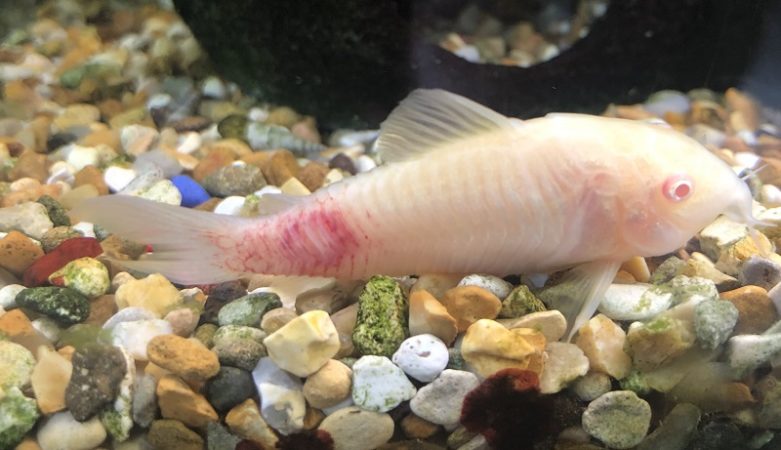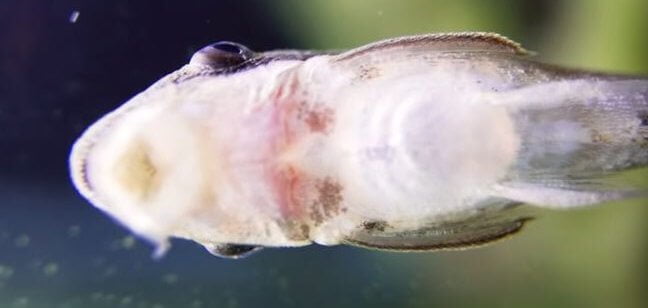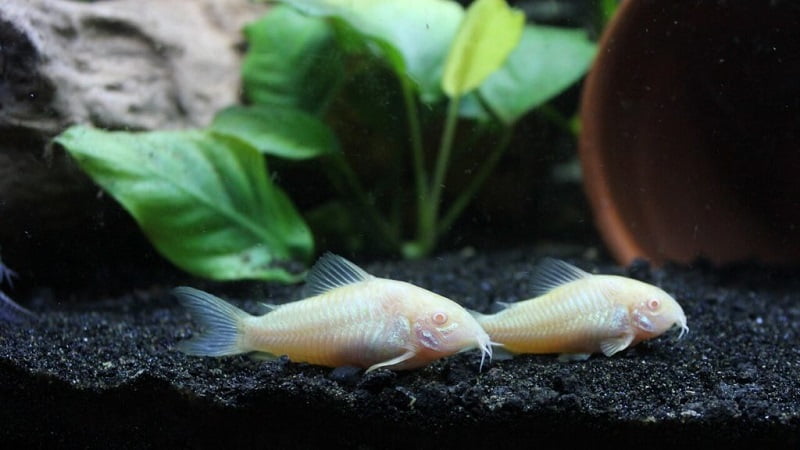Internal bleeding is a serious stage of disease infection on your cory catfish. So what are the main causes of cory catfish internal bleeding? Are there any potential treatments and preventions for such infections? The answers are all included in this article!
Causes Of Cory Catfish Internal Bleeding
Hemorrhagic Septicemia
Hemorrhagic Septicemia (HS) refers to an internal bacterial infection within the fish’s blood vessels. The bacteria will cause damage to body tissues, blood vessels, and the heart if they enter your fish’s circulatory system. This often results in internal bleeding.
HS occurs when parasites or bacteria infect fish’s open wounds and when bacteria are in the food consumed by the fish.
Septicemia is particularly transmitted through feeding fish live and/or frozen foods contaminated with pathogens; this is especially common with tubifex and blackworms of poor quality.

Cre: Abi Jones on UK Aquatic Plant Society (UKAPS)
– Symptoms:
- The most common symptoms of Septicemia are redness under the scales, hemorrhages, and ulcerations. Even though it can affect a specific region of the body, it usually affects the whole body of fish.
- There are also other symptoms that can be early indicators of Septicemia, including color loss, loss of appetite, sluggishness, and clamped fins.
- In some cases, Septicemia can result in Popeye (exophthalmia), and Dropsy.
- Be on the lookout for abnormal behaviors such as hyperventilation (fast breathing), gasping at the surface, and erratic swimming to identify diseases.
– Causes:
Septicemia can be caused by either a bacterial infection from the Aeromonas bacteria genus or viral hemorrhagic Septicemia – VHS.
Viral Hemorrhagic Septicemia (VHS)
- VHS is a deadly fish virus and can easily lead to the death of your infected cory catfish.
- The virus shed by infected fish can survive in water for at least 14 days, and it can be contained in the fish’s urine or reproductive fluids.
- First, VHS virus particles in the water affect the fish gill tissue and then spread to the internal organs and blood vessels. As a result, their blood vessels are weakened, resulting in hemorrhages in the stomach, intestines, muscles, and skin.
- It is also possible for fish to become infected when they consume infected fish.
- Stress contributes significantly to VHS outbreaks since the immune system is suppressed when under stress, which makes infected fish sick.
- Spawning hormones, poor water quality, poor nutrition, and overhandling of fish are among the stress-triggered factors for the fish.
Aeromonas bacterial infection
- The infectious bacterium Aeromonas hydrophila causes diseases in fish referred to as “Motile Aeromonas Septicemia,” “Hemorrhagic Septicemia,” and “Ulcer Disease.”
- There are many synonyms for this disease that refer to the lesions caused by the bacteria, including Septicemia. In septicemia disease, bacteria are present in numerous organs of the fish, and ulcers on its skin.
- This disease in fish is frequently caused by stress factors or unsatisfactory living conditions, such as poor water quality, overcrowded conditions, and nutrient-deficient diets.
- Fish infected with Aeromonas hydrophila may exhibit a wide range of symptoms. A fish may die suddenly or exhibit other symptoms, such as lack of appetite, swimming abnormalities, pale gills, swelling, or skin ulcers.
- Additionally, this disease is known to affect the gills, kidneys, liver, spleen, pancreas, and skeletal muscle.
Ammonia and nitrate poisoning
- High ammonia levels are toxic to freshwater fish and can lead to the “chemical burn” in fish’s eyes, skin, fins, and gills.
- In addition, ammonia burns can cause internal and external bacterial infections and sudden death from ammonia poisoning.
- The fish’s skin will show damage due to ammonia burns, causing red skin areas to appear irritated, ragged fins, or even cloudy, red-eye “burn.”
- High nitrate levels contribute to the high probability of being more susceptible to infection by Aeromonas hydrophila.

Treatment & Prevention:
Treatment
For Hemorrhagic Septicemia
- An antibiotic treatment regimen is the quickest and most effective way to treat Septicemia in the fish bloodstream. Besides, Septicemia is an internal bacterial infection, so it requires a medicated fish food with antibacterial properties to better target the infection.
- To treat Aeromonas infection, Terramycin, an oxytetracycline, and Remet-30, a potentiated sulfonamide, can be used. For Terramycin, the dosage is 2.5-3.75 g/100 lb of fish per day for 10 days in feed, and for Remet-30, it is 50 mg/kg of fish per day for 5 days.
- Treatment of Septicemia can also be achieved by soaking pellets in a concentrated mixture of Mardel’s Maracyn and Maracyn 2. The amount you would normally use to treat the tank can be chopped up, added to a few drops of water, soaked through several pellets in the mix for 10 minutes, and then fed to the affected fish. Fill the tank with the premeasured mixture as directed.
- Use the standard method of adding antibiotics to the water if your fish is no longer eating.
- Since many tropical fish keepers cannot determine what kind of bacteria has been infected their fish, using a broad-spectrum antibiotic or combination (like the ones below) that treats both gram-positive and gram-negative bacteria is highly recommended.
- Use 1 ml of 0.2% Acriflavine or Monacrin per liter to disinfect. These will color your aquarium’s water but will disappear as they disperse. Discontinue using them if your fish do not react positively.
- As an alternative, you can add an antibiotic to the food. Chloromycetin or tetracycline are good choices. They usually come in 250mg capsules, so one should be enough to mix into 25g of flakes. Make sure your fish are hungry so they will consume the mixture before it dissipates.
- It is best only to use antibiotics when necessary or when all other treatments have failed. Antimicrobial resistance and residues can be minimized by following the manufacturer’s instructions, which will help to prevent the evolution of newer and more resistant strains of bacteria that cannot be treated with antibiotics.
For ammonia burns
- Performing a water change immediately after an ammonia burn is the first step to treating it. Ensure the ammonia level in the water has been sufficiently lowered by testing it with an ammonia test kit.
- You should then isolate fish that may be developing secondary bacterial infections in a quarantine tank.
- Ensure that the quarantine tank’s fish is treated with quality antibiotics or antibacterial medications.
- Antibiotics should not be given to the fish in the main aquarium. The medications can cause extensive damage to and even kill off the biological filter bacteria, leading to the occurrence of new tank syndrome or the aquarium having to start over again.
- Successful antibacterial treatment usually takes three to five days to take effect. It is necessary to continue treatment until the fish are eating normally, after which they can be returned to the main tank.
Prevention
As demonstrated, both causes of cory catfish internal bleeding can be easily triggered by poor water quality and other stress factors such as poor-nutrient diet, overcrowding, and extreme handling.
Therefore, the best prevention is to reduce the stressors on your cory catfish. The following actions can be taken to reduce the risk of infection on your catfish.
- Water should be changed and tested regularly to avoid bacteria building up that may cause Septicemia.
- It is important to have a biological filter (biofilter) that breaks down the ammonia produced by the fish to keep them safe.
- Avoid overcrowding your aquarium since fish waste can accumulate quickly regardless of your good filtration system.
- Avoid overfeeding your fish. It is preferable to feed them in small quantities of quality foods twice or three times daily to avoid waste buildup.
- Make sure that only compatible species are kept together in community tanks. When necessary, separate or remove new additions if they are bullying or nipping.
- Keep an eye out for changes to their fins, tails, body, appetite, and behavior.
- Quarantine newly acquired fish before adding them to your community tank. The detection and treatment of fish diseases are easier in a quarantine tank than in a community environment.
Video: How To Treat For Internal Parasites In Your Fish
Conclusion
Cory catfish internal bleeding is a severe symptom of ammonia poisoning or infection from Septicemia diseases. The environmental stress factors significantly cause your cory catfish to be vulnerable to these infections.
Therefore, you should keep the good water quality by doing water changes regularly to reduce the ammonia levels, and testing other water factors such as nitrate, pH, and temperature levels to be able to adjust timely. Besides, avoid stocking your cory catfish at high density to reduce stress as well as the changes of spreading diseases.
References:
http://dx.doi.org/10.1088/1755-1315/493/1/012036
https://dnr.wisconsin.gov/topic/Fishing/vhs#threea

Annette M. Chaney is an experienced marine biologist with over 20 years of experience as an aquarist and fishkeeper. She started her first aquarium at a young age, filling it with frogs and goldfish obtained from the ten-cent pet store.
Annette grew up caring for and breeding African Cichlids, which led to a hobby in high school that doubled as a profitable means. Attending Reed College gave her time to solidify herself as an accomplished aquarium caretaker with an eye for sales. After that, from 2009 – 2013, she studied at Roger Williams University – one of the most prestigious universities for Aquaculture and Aquarium in USA. She is the founder of AquariumCircle since 2010.
